Some time ago, I was giving a workshop in England for about twenty of Kay Laurence's advanced students. After lunch I embarked on a new exercise about teaching cues, and looked around to choose a dog to work with. A huge German shepherd was watching me.
"What about him," I asked Kay.
"Yes, fine, all right," Kay said.
I trust Kay's dog sense, and this was her student so presumably she knew the dog. The owner however was dubious. "I don't think he'll work for anyone but me." Well, I don't want to step on your ego, I thought, but let's find out.
I ascertained his name and invited him over. He came at once. The dog, after all, had been lying there all morning watching other dogs earn clicks and treats. He'd probably been thinking "I could do that," up to and including learning to jump rope as one clever collie had done.
What we were going to work on was transferring the cue for a particular behavior, from a word to a visual signal. What behavior did he have that was already on cue?
"Sit," I asked, and he dutifully sat. OK, we'll use that, I thought, and clicked and gave him a treat. The treats were tiny—a quarter-inch square of bologna each. Ouch. He was, as they say, hard-mouthed, and nipped my fingers accidentally, trying to take the treat. Kay can cure that in four clicks, I've seen her do it, by shaping the behavior of taking the treat with lips and tongue rather than jaws and teeth; but I am not as deft and it takes me longer, which bores the audience. So, to spare my fingers, when I find myself doing a demonstration with a dog that takes food roughly I usually give the treat from the floor. After the next click I dropped the treat onto the carpet. Wow, the dog caught it on the way down. He was a good catcher! So we arrived at another arrangement: "After each click I'll toss the treat, and you catch it." OK, said the dog.
I confess I had been a bit daunted by this very large and formidable-looking dog when he first stepped forward. Now, however, we were in business together and I soon came to admire him very much. He quickly demonstrated that he could sit reliably on the verbal cue, so we proceeded to the second part of the lesson. I grabbed up a blue plastic bowl from the equipment table and showed it to him. This was going to be the new cue for "sit."
The way you transfer a cue is: Give the new cue, give the old cue, get the behavior, click, treat. Repeat: new cue, old cue, behavior, click treat. I held out the blue bowl, said "sit," the dog sat, I clicked and tossed a treat. After a few rounds of that, the next step is, you give the new cue, and pause. If you get even a whiff of the behavior, click, treat. Repeat that a few times, and the learner's confidence will grow. Soon the behavior will be offered on the new cue. In this case, after several repetitions of presenting the blue bowl, and pausing before saying "sit," the dog hesitantly crouched on his hindquarters a little when he saw the bowl. It was the start of a "sit" behavior and I clicked it. A few clicks later the dog was sitting, promptly and confidently, each time the blue bowl appeared.
At this point the dog began sitting as soon as he'd caught his previous treat, whether he'd seen the bowl or not. "I know what she wants! I'll sit again!" The final stage would be to teach him to wait for the new cue: not to just sit on his own, in anticipation, before the cue was presented. I accomplished this by holding the bowl behind my back, and then taking advantage of a moment when he had just finished catching a treat and was still standing up and showing him the bowl. If he sat off-cue, that is, before I offered the bowl, I just moved a few feet away, so he had to stand up and move, too, to stay near me.
Then I presented the bowl again. If my timing was right the bowl was presented during "standing up and waiting" behavior, thus rewarding that behavior. I was in effect using the cue presentation to reward the dog for waiting for the cue to be presented, a very quick and pleasant way to teach a dog to "obey" a new signal.
Of course I made mistakes. Sometimes I held out the bowl when I meant to put it behind my back, sometimes I clicked late, and so on. But the system is pretty forgiving. If most of the connections are right, you can get the job done. When I finally saw that the dog was deliberately controlling himself as he waited, crouching a little but keeping himself from sitting until he got the cue, I considered the mission accomplished. I ended the lesson with a big jackpot: I let him dive into a whole bowl of treats, for one satisfying mouthful.
All this time, as I tossed the treats here, there, and everywhere, the dog got better and better at catching. He could jump up as high as my head. He snatched his reward in midair with an audible chomp of those powerful jaws. He was having fun and so was I. It was a bit like training a killer whale. It's rather exciting to have all that energy (and all those teeth) in midair and right in front of you, and yet feel safe.
A year later, I gave a lecture at the Association for Pet Dog Trainers (APDT) on the same exercise, how to transfer the cue. Before doing a demo with a live dog from the audience, I showed the video of this episode with the German shepherd and the blue bowl. From the camera's angle the shepherd's catches were awesome. Too awesome for one woman in the audience, who came up to me afterwards in the hall and said, scowling, "You taught that dog to jump up. You taught that dog to snap." No, he already knew that, I thought, and laughed, but I didn't say anything, and my giggle no doubt confirmed her judgment that I was an idiot.
I understood her distress, and I doubted any verbal explanation would help. What I had taught the dog, without thinking about it particularly at the time, was a controlled leap and a controlled chomp. Just exhibited at random these are not nice behaviors, especially from a dog of that size and strength. In this session, however, the dog had learned to do them on cue. Trainer: Click. Trainer: cocks hand, ready to toss. The dog, seeing the hand motion, gathers himself. Toss, jump, chomp. It's a little behavior chain, under stimulus control (the hand position) and rewarded by the actual food-in-mouth. And what happens when behavior is under stimulus control, class? It tends to disappear in the absence of the stimulus. This dog was now far less likely to snap at food, or leap at people spontaneously, because he could control himself and do those things on purpose and on cue.
This traditional trainer was upset at seeing potentially hazardous behavior actually encouraged. In standard-practice training, one would try to "correct" such behaviors whenever they occurred, meaning one would aim to suppress them with punishment. I think my way of getting rid of random leaping and food snatching is more elegant. And we did it on the fly, so to speak, while the dog also learned something about controlling himself in the matter of waiting for cues.
Back in England, a couple of days after the blue-bowl episode, in a different lecture hall in a different town, that owner and that dog were in the front row. The dog clearly wanted to be up on stage, and this time the owner gave me permission with a big grin. When I called him the dog came galloping up the steps onto the stage with a big grin too. He quickly demonstrated that he remembered his blue bowl, his sit, and his four-star midair catch too.
I might not have been quite so insouciant with him if I'd known his history, or rather, his lack of history. That night in a pub I found out from Kay that the shepherd was not a family pet; he'd been adopted two weeks earlier, and no one knew anything about him. Who knows what event had made him homeless, or what misbehavior might lie in his background? He had come to trust his new owner a little, but she was quite right when she said she didn't know if he'd work for someone else. Clicker training, however, doesn't require personal trust; it builds it. In two directions: dog to person, and person to dog. And that certainly had worked, for both of us.
Teaching a dog to catch
Teaching a dog to catch is a matter of what trainer Margi English calls eye-fang coordination. Some are better at it than others, but most of them can learn—if they want to. Take my poodle Misha. Misha can catch things, but he has to know what it is, first. Hold out a treat, say "catch" and Misha goes "Ew, but what is it? What if you throw me something disgusting?" Never in his whole life have I thrown him something disgusting, but he worries anyway. If I just toss the treat he ducks, and the treat hits him in the face. He will catch…provided he first has a chance to smell and inspect what I'm holding, which kind of spoils that desirable appearance of joyous spontaneity.
Virginia Broitman and Sherri Lippman, authors of the excellent Bow Wow clicker training videos, have taught thousands of people to teach their dogs to catch.
Here's their recipe:
- Start with your dog in a quiet place, a clicker, and very high-value treats. (Cut up steak, say. Make the pieces big enough so he can easily see them; marble-sized.)
- Ask him to sit. Calmly give him two or three treats from your hand, one at a time, so he knows what you have. (No clicking needed.)
- Now fake-toss a treat, moving your hand as if you were going to throw it underhand, and end up putting it gently in his mouth. This gets him used to the rapid moving of your hand toward him, in case that alarms him at first. Do this two or three times.
- Now, if his head moves, anticipating where the treat is going, click and then treat. You want to click WHILE the head is moving, not while you treat.
- Then actually toss the treat, underhand, so that it goes up and then down again, giving him plenty of time to see it and catch it. If it falls to the floor, quickly pick it up and put it away in a dish. Now it's YOUR treat.
- If he is very clumsy at first, click efforts to catch, and quickly hand-feed him a new treat. Don't let him pick up the dropped one, that's yours. (Is he quick? You have to be, too; put your foot on it. Or let some other dog take the fallen treat, very motivating for the animal that lost it.)
- Do this before meals. Or skip a meal, and then play catch. There are many variations: Catch a toy. Catch a ball. Put a treat on the dog's nose; on cue he tosses it up and catches it. Or a fiendish Broitman/Lippman variation: one dog tosses a biscuit over his back and another dog, sitting behind him, catches it.
- Go to a Bow Wow weekend and your dogs can learn to do this too!
Catch recipe developed by Virginia Broitman and Sherri Lippman


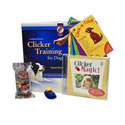
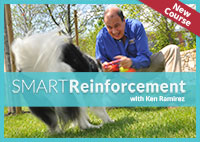
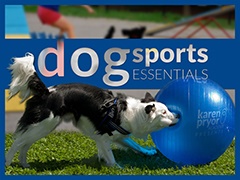
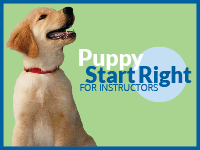
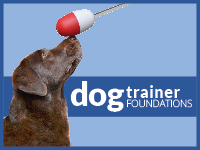

Post new comment